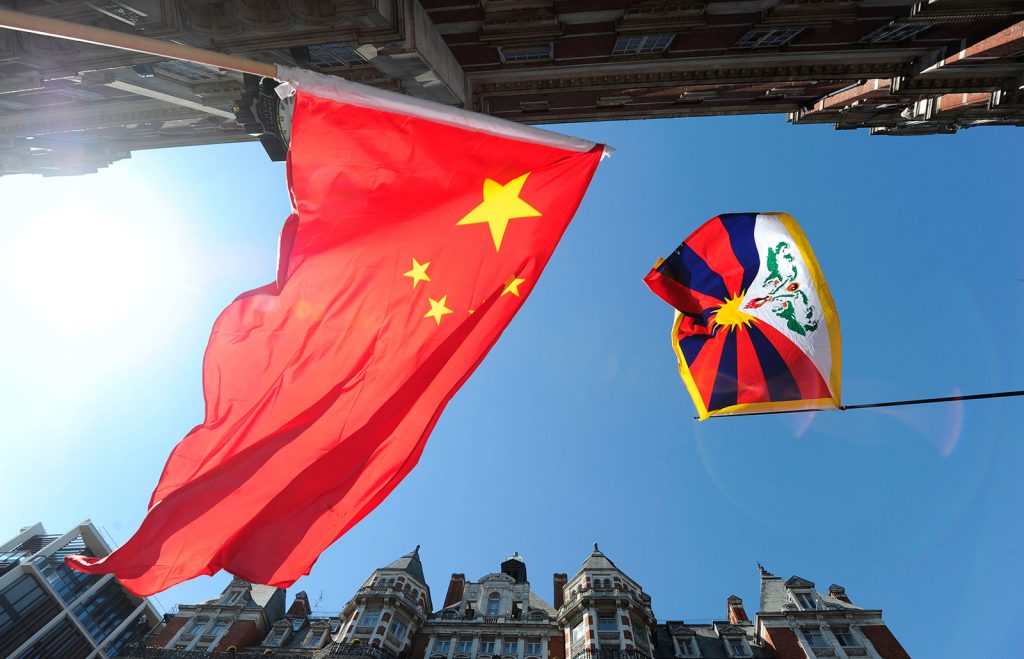Imagine at the age of twenty-three having to walk at night across the Himalayan mountains, to survive and avoid imprisonment, torture, and certain death. This is the only choice the 14th Dalai Lama, Tenzin Gyatso, could make to avoid being imprisoned and most likely killed by the Chinese military.1 This set him on a perilous journey that required him to travel by night, dressed as a soldier, for two weeks and across the tallest and most lethal mountain range, the Himalayas. 2 This was his only option because the fate of his people and their ancient culture depended on his survival.3

Tibet is nestled between the Southwestern border of China, and the Northeastern border of Nepal. Prior to China’s invasion of Tibet in 1950, Tibetan society was governed by a caste system centered around the Buddhist principle of reincarnation, the religion for a country ran as a Theocracy.4 Buddhist reincarnation suggests that if an individual lived a virtuous life, following his or her death, he or she reincarnates into the next highest caste and enjoys said caste’s privileges as the reward of a deeply humble and virtuous life. The one who served as a symbol of unity for the people and who ruled the country by maintaining Tibetan traditions in combining the duties of the spiritual leader and political leader of Tibet is the Dalai Lama.5 The Dalai Lama is not representative of any one school of Buddhist thought, instead he advocates traditional Buddhist values and the preservation of Tibetan traditions.

During the near two-hundred-year rule of China’s Qing Dynasty (1720- 1912), the Dalai Lama was the head of Tibet’s government, with the government enjoying almost complete sovereignty at times. Following the collapse of the Qing Dynasty, in 1914 a convention was held in which British India, China, and Tibet agreed to make Tibet semi-autonomous. 6 Under the agreement China, which never had full control over Tibet, handled Tibet’s foreign relations while Tibet handled its internal affairs and maintained an army. However, thirty-five years later, the plan to rob Tibetans of their autonomy and rights was set in motion.
In 1949, Mao Zedong established China as a communist state known as the People’s Republic of China. A mere two months later Mao ordered the “liberation” of Tibet from its Buddhist leaders.7 The Chinese government painted the Dalai Lama as the architect of a regressive and feudal regime, and promoted themselves as a heroic force of change. 8 Mao believed that Tibet only enjoyed autonomy due to the machinations of foreign influences. He cited Chinese traditions that claimed Tibetans were one of the five races that made up China as evidence that Tibet’s rightful place was as a province of China.9 In 1950, the Chinese military invaded Tibet and defeated its army. Instead of occupying the country, the Chinese government invited Tibetan officials to negotiate an agreement between the two. At the meeting, the Tibetan representatives signed a Seventeen-Point Agreement, acknowledging China’s sovereignty over Tibet.10 The Tibetan government refuted this agreement’s legitimacy, claiming that the delegation sent was not authorized to sign any such documents, nor were they allowed to communicate back home the nature of their situation. It was this combination of Tibet’s military defeat and forced signing of the agreement that set the stage for Mao’s occupation of Tibet and the erosion of Tibet’s freedom and rights.
In 1951, China began exerting its newly affirmed control over Tibet by sending troops into the country and implementing communist reforms. The first reform implemented was the settling Tibetans who were typically a nomadic people and the settlement of more Chinese citizens to the region. The second reform instituted was land redistribution, crops were confiscated by the Chinese government and given to a central authority with only a small amount returned to Tibetans. However, land redistribution was not implemented uniformly across Tibet, reforms were inexplicably delayed in western Tibet, and society largely continued unchanged. Eastern Tibet on the other hand rebelled in 1956, with monasteries and noblemen leading the resistance against Chinese Communists. Guerilla fighters were successful in capturing control of Southern Tibet, however this uprising was costly. The Tibetan uprising of 1959 alone costing anywhere from 85,000 to 87,000 lives, and the response by China resulted in 10,000 to 15,000 Tibetans dying over the course of three days. Fearing the capture of the Dalai Lama, Tibetan citizens surrounded his residence in an effort to protect him.11 Tibetans chose to stand against the Chinese troops outraged by the previous nine years of egregious human rights violations that included many soldiers raping and murdering Buddhist nuns and monks who resisted the reforms.
With this opportunity to escape provided to him by his people the Dalai Lama began is harrowing thirteen-day trek on foot through the Himalayas to India. Upon arriving in India, representatives sent by Prime Minister Nehru welcomed him and the refugees that had followed hoping to escape the atrocities currently being inflicted upon their homeland. The Dalai Lama worked alongside his people who fled to establish the Tibetan government in exile in Dharamshala, Himachal Pradesh, India.

During his time as both the head of the exiled government and after having stepped down from said position the Dalai Lama has worked furiously advocating not just the rights of Tibetans, but people all across the globe.12 The Dalai Lama has spoken on a variety of social issues ranging from the environment, to economics, reproductive health, sexuality, interfaith dialogue, women’s rights, and nonviolence. “Furthermore, everyone appreciates affection and at the same time has the potential for showing affection to others. With this in mind, I have found that friendship and understanding can develop.”13 All while being unable to return to his home of Tibet and not knowing how his subsequent reincarnation was to be found. His existence challenges the Chinese government’s blatant disregard for human rights, which include massacres, tortures, killings, bombardment of monasteries, extermination of nomad camps, and violating at least sixteen articles of the Universal Declaration of Human Rights. Now 81 years old, he may be the last Dalai Lama. The Dalai Lama is traditionally found following his reincarnation by the Panchen Lama, someone who is akin to our U.S. Vice President. Along with the numerous human rights violations committed the Chinese government also arrested both the Panchen Lama and his family, then named their own Panchen Lama in 1995, thereby creating uncertainty as to whether the next reincarnation would follow Tibet’s traditions or serve the Chinese government’s interests.14 To dispel this fog of doubt and concern, the Dalai Lama announced a plan to determine the future of his reincarnation, upon him turning ninety, the Dalai Lama will convene with a trust to decide if it is necessary for a 15th Dalai Lama to be recognized. If it is determined that his reincarnation is necessary, then the Gaden Phodrang Trust will search for and recognize the 15th Dalai Lama, along with the caveat that any person chosen by the Chinese government is to be dismissed by all people.15
Despite attacks on his home, his religion, and himself, the Dalai Lama persists in refusing to call for violence against China. For over fifty years this man, now in the twilight of his life, has spread his message of peace and understanding to the world hoping he could help country and his people one day see the restoration of their basic human rights following years of blatant abuse and maltreatment.16
- Charles George and Linda George, The Dalai Lama, (People in the News. Detroit: Lucent Books, 2010), 50-51. ↵
- Latson Jennifer, How and Why the Dalai Lama Left Tibet, www.time.com. ↵
- Charles George and Linda George, The Dalai Lama, (People in the News. Detroit: Lucent Books, 2010), 37. ↵
- Charles Bell, Tibet and Its Neighbors, (Vancouver: Pacific Affairs, University of British Columbia, 1937), 428-440. ↵
- Robert Thurman, Why The Dalai Lama matters, (New York: Atria Books, 2008), 3. ↵
- Jennifer Stock, Global Events: Milestone Events Throughout History: Vol 2: Asia and Oceania, (Farmington Hills: Gale, 2014), 373-376. ↵
- Charles Henry Alexandrowicz-Alexander, The American Journal of International Law: Vol. 48: No. 2, (Cambridge: Cambridge University Press, 1954), 265-274. ↵
- Charles George and Linda George, The Dalai Lama, (People in the News. Detroit: Lucent Books, 2010), 9. ↵
- Elliot Sperling, Tibet and China: The Interpretation of History Since 1950: China Perspective Vol 3, (2009), 25-26. ↵
- Alex McKay, The History of Tibet: Vol 3 The Modern Period: 1859- 1959, (London and New York: Routledge Curzon, 2003), 607-609. ↵
- Charles George and Linda George, The Dalai Lama, (People in the News. Detroit: Lucent Books, 2010), 47-48. ↵
- His Holiness The Dalai Lama and Howard C. Cutler, The Art of Happiness,(New York: Riverhead Books, 1998), 2. ↵
- Charles George and Linda George, The Dalai Lama, (People in the News. Detroit: Lucent Books, 2010), 64. ↵
- Eric A. McGuckin, Tibet: Struggle for Independence.” In History Behind the Headlines: The Origins of Conflicts Worldwide, (Farmington Hills: Gale, 2003), 272. ↵
- The Dalai Lama, Reincarnation, (Dharamsala: The Dalai Lama, 2011). ↵
- Gary L. Anderson and Kathryn G. Herr, Encyclopedia of Activism and Social Justice, Vol. 3, (Thousand Oaks: Sage Publications Inc, 2007), 417-418. ↵



51 comments
Haley Ticas
This was a very informative read that taught me a lot about the conflict between the country of China and the peaceful country of Tibet. I was unaware of any of this conflict occurring before reading this article. I found it fascinating all that the Dali Lama has been through such as his journey across the Himalayas. This article effectively told the story of a man traveling in order to save his people and represent the Buddhist nation of Tibet which China refused to acknowledge as independent.
Camila Garcia
This article was very well written and interesting, the authors writing style is amazing. I had no idea about this conflict and the article informed me, I feel as if everyone should read this article because it highlights how cruel China can be, they are refusing to acknowledge a whole nation of people, I like how serious the article was and how it drew attention to something that is not talked about enough.
Edward Cerna
I really enjoyed reading this article because it covers a topic I was not familiar with and I was able to educate myself by reading this article. I was aware of the tension that is in China but I was unaware of the other aspects that this article covers such the tension between Tibet and China. This article is very well written and it was a good read as the layout was very good.
Victor Rodriguez
Really wonderful story. I did not know how much Tibet had struggled as a country before reading this country. China has been suppressive and abusive with many other neighbor countries around them. I am amazed how there was not a compromise to relieve the tension. The diplomatic and legitimate tensions they have had as a country has made Tibet a really poor developed country in a variety of ways. Countries with greater strength should not use aggression against other countries.
Aaron Peters
I found this article to be really insightful given the recent talk of the US being in an ongoing Trade War. . I found this artlcle gave me a an interesting look into how the Chinese Communist Party handled the Tibetans with what seems to be total domination currently. I was also impressed by the Dalai Lama sticking to his principles of nonviolence and calling for a peaceful resistance of the regime. It can be hard to do so even in the most dire situations.
Danielle Slaughter
Hey, Robert.
I have, of course, long admired the Dalai Lama for his commitment to his faith and his belief in the equality and value of all life on Earth. However, I was never aware of his incredible escape and his equally committed quest to secure the rights and sovereignty of his fellow Tibetans. What China has done in Tibet is nothing short of an atrocity – stripping an entire culture’s identity is psychological warfare of the highest caliber. I do hope that Tibet may one day attain its sovereignty and rise to the ranks of a prosperous nation.
Marian Reyes
To be completely honest, I was only marginally aware of the China-Tibet conflict. I enjoyed this article because it not only informed me, but also put into perspective exactly how much the Tibetan people have to lose in this situation. Their entire cultural identity is in danger due to the actions of the Chinese government, and I like that this article treated this situation with the seriousness it deserved.
Karla Cardenas
This is really well written. I wasn’t aware of the China-Tibet conflict until after reading this article. I wasn’t aware how China didn’t acknowledge Tibet as an independent nation, even though they have gone through their struggles to warrant itself to be acknowledged as one. They have such contrasting beliefs that it’s not hard to believe how they going through conflicts. This is very well written and so informative!
Valeria Varela
I heard a little bit about this conflict, china’s act in seized control over Tibet which they once described it as a “peaceful liberation” because it would somehow be beneficial is sad. They took advantage of tibet in a moment of vulnerability which the Dalai Lama criticized and mentioned Beijing’s rule amounts to “cultural genocide”. I didn’t know that it was as big as this though. the amount of deaths and damage the Chinese government caused was uncalled for. It was a great and informative article.
Aaron Sandoval
I had a great experience reading this article, I am vaguely aware of the conflicts that China is in, and know very little of the China-Tibet conflict. This article was well written and did a good job covering that conflict. The little I know about the Tibet conflict is saddening, and the situations they have been forced to endure over the decades is shocking, especially the efforts made by the Dali Lama. I am very curious to learn more about the China-Tibet conflict.